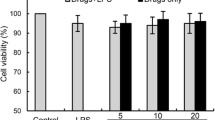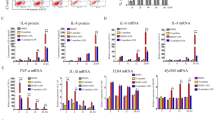ABSTRACT
Periodontitis is a chronic disease that affects the gums and destroys connective tissue. Acanthoic acid (AA), a diterpene in Acanthopanax koreanum, has been reported to have anti-inflammatory activities. The aim of this study was to investigate the anti-inflammatory effects of AA on lipopolysaccharide (LPS)-induced inflammatory response in human gingival fibroblasts (HGFs). HGFs were treated with Porphyromonas gingivalis LPS in the presence or absence of AA. The production of inflammatory cytokines IL-8 and IL-6 were measured by ELISA. The expression of NF-κB and TLR4 were detected by Western blotting. The results showed that AA inhibited LPS-induced IL-8 and IL-6 production in a dose-dependent manner. In addition, AA inhibited LPS-induced TLR4 expression and NF-κB activation. In conclusion, AA inhibits LPS-induced inflammatory response in HGFs through inhibition TLR4-mediated NF-κB signaling pathway.




Similar content being viewed by others
REFERENCES
Garlet, G.P. 2010. Destructive and protective roles of cytokines in periodontitis: A re-appraisal from host defense and tissue destruction viewpoints. Journal of Dental Research 89: 1349–1363.
Van Dyke, T.E. 2008. The management of inflammation in periodontal disease. Journal of Periodontology 79: 1601–1608.
Sun, Y., R. Shu, C.L. Li, and M.Z. Zhang. 2010. Gram-negative periodontal bacteria induce the activation of toll-like receptors 2 and 4, and cytokine production in human periodontal ligament cells. Journal of Periodontology 81: 1488–1496.
Padilla, C., O. Lobos, E. Hubert, C. Gonzalez, S. Matus, M. Pereira, S. Hasbun, and C. Descouvieres. 2006. Periodontal pathogens in atheromatous plaques isolated from patients with chronic periodontitis. Journal of Periodontal Research 41: 350–353.
Kuula, H., T. Salo, E. Pirila, A.M. Tuomainen, M. Jauhiainen, V.J. Uitto, L. Tjaderhane, P.J. Pussinen, and T. Sorsa. 2009. Local and systemic responses in matrix metalloproteinase 8-deficient mice during porphyromonas gingivalis-induced periodontitis. Infection and Immunity 77: 850–859.
O’Brien-Simpson, N.M., R.D. Pathirana, R.A. Paolini, Y.Y. Chen, P.D. Veith, V. Tam, N. Ally, R.N. Pike, and E.C. Reynolds. 2005. An immune response directed to proteinase and adhesin functional epitopes protects against Porphyromonas gingivalis-induced periodontal bone loss. Journal of Immunology 175: 3980–3989.
Park, H.J., S.K. Jeong, S.R. Kim, S.K. Bae, W.S. Kim, S.D. Jin, T.H. Koo, H.O. Jang, I. Yun, K.W. Kim, and M.K. Bae. 2009. Resveratrol inhibits Porphyromonas gingivalis lipopolysaccharide-induced endothelial adhesion molecule expression by suppressing NF-kappa B activation. Archives of Pharmacal Research 32: 583–591.
Thompson, P.A., K.C. Gauthier, A.W. Varley, and R.L. Kitchens. 2010. ABCA1 promotes the efflux of bacterial LPS from macrophages and accelerates recovery from LPS-induced tolerance. Journal of Lipid Research 51: 2672–2685.
Herath, T.D.K., R.P. Darveau, C.J. Seneviratne, C.Y. Wang, Y. Wang, and L.J. Jin. 2013. Tetra- and penta-acylated lipid a structures of Porphyromonas gingivalis LPS differentially activate TLR4-mediated NF-kappa B signal transduction cascade and immuno-inflammatory response in human gingival fibroblasts. Plos One 8.
Graves, D. 2008. Cytokines that promote periodontal tissue destruction. Journal of Periodontology 79: 1585–1591.
Zhou, Q.D., T. Desta, M. Fenton, D.T. Graves, and S. Amar. 2006. Cytokine profiling of macrophages exposed to Porphyromonas gingivalis, its lipopolysaccharide, or its FimA protein (vol 73, pg 935, 2005). Infection and Immunity 74: 1995.
Wu, Y.L., Y.Z. Jiang, X.J. Jin, L.H. Lian, J.Y. Piao, Y. Wan, H.R. Jin, J.J. Lee, and J.X. Nan. 2010. Acanthoic acid, a diterpene in Acanthopanax koreanum, protects acetaminophen-induced hepatic toxicity in mice. Phytomedicine 17: 475–479.
Traves, P.G., M. Pimentel-Santillana, D. Rico, N. Rodriguez, T. Miethke, A. Castrillo, E.A. Theodorakis, P. Martin-Sanz, M.A. Palladino, L. Bosca. 2014. Anti-inflammatory actions of acanthoic acid-related diterpenes involve activation of the PI3K p110gamma/delta subunits and inhibition of NF-kappaB. Chemical Biology.
Kang, H.S., H.K. Song, J.J. Lee, K.H. Pyun, and I. Choi. 1998. Effects of acanthoic acid on TNF-alpha gene expression and haptoglobin synthesis. Mediators of Inflammation 7: 257–259.
Kim, J.A., D.K. Kim, T. Jin, O.H. Kang, Y.A. Choi, S.C. Choi, T.H. Kim, Y.H. Nah, S.J. Choi, Y.H. Kim, et al. 2004. Acanthoic acid inhibits IL-8 production via MAPKs and NF-kappaB in a TNF-alpha-stimulated human intestinal epithelial cell line. Clinica Chimica Acta 342: 193–202.
Kang, O.H., D.K. Kim, X.F. Cai, Y.H. Kim, and Y.M. Lee. 2010. Attenuation of experimental murine colitis by acanthoic acid from Acanthopanax koreanum. Archives of Pharmacal Research 33: 87–93.
Nan, J.X., X.J. Jin, L.H. Lian, X.F. Cai, Y.Z. Jiang, H.R. Jin, and J.J. Lee. 2008. A diterpenoid acanthoic acid from Acanthopanax koreanum protects against D-galactosamine/lipopolysaccharide-induced fulminant hepatic failure in mice. Biological and Pharmaceutical Bulletin 31: 738–742.
Ara, T., K. Kurata, K. Hirai, T. Uchihashi, T. Uematsu, Y. Imamura, K. Furusawa, S. Kurihara, and P.L. Wang. 2009. Human gingival fibroblasts are critical in sustaining inflammation in periodontal disease. Journal of Periodontal Research 44: 21–27.
Kudva, P., N. Saini, H. Kudva, and V. Saini. 2014. To estimate salivary aspartate aminotransferase levels in chronic gingivitis and chronic periodontitis patients prior to and following non-surgical periodontal therapy: A clinico-biochemical study. Journal of Indian Society of Periodontology 18: 53–58.
Page, R.C. 1999. Milestones in periodontal research and the remaining critical issues. Journal of Periodontal Research 34: 331–339.
Chi, X.P., X.Y. Ouyang, and Y.X. Wang. 2014. Hydrogen sulfide synergistically upregulates Porphyromonas gingivalis lipopolysaccharide-induced expression of IL-6 and IL-8 via NF-kappaB signalling in periodontal fibroblasts. Archives of Oral Biology 59: 954–961.
Shu, L., S.M. Guan, S.M. Fu, T. Guo, M. Cao, and Y. Ding. 2008. Estrogen modulates cytokine expression in human periodontal ligament cells. Journal of Dental Research 87: 142–147.
Tamura, T., N. Udagawa, N. Takahashi, C. Miyaura, S. Tanaka, Y. Yamada, Y. Koishihara, Y. Ohsugi, K. Kumaki, T. Taga, et al. 1993. Soluble interleukin-6 receptor triggers osteoclast formation by interleukin 6. Proceedings of the National Academy of Sciences of the United States of America 90: 11924–11928.
Wang, P.L., and K. Ohura. 2002. Porphyromonas gingivalis lipopolysaccharide signaling in gingival fibroblasts-CD14 and Toll-like receptors. Critical Reviews in Oral Biology and Medicine 13: 132–142.
Darveau, R.P., T.T.T. Pham, K. Lemley, R.A. Reife, B.W. Bainbridge, S.R. Coats, W.N. Howald, S.S. Way, and A.M. Hajjar. 2004. Porphyromonas gingivalis lipopolysaccharide contains multiple lipid a species that functionally interact with both toll-like receptors 2 and 4. Infection and Immunity 72: 5041–5051.
Joh, E.H., W. Gu, and D.H. Kim. 2012. Echinocystic acid ameliorates lung inflammation in mice and alveolar macrophages by inhibiting the binding of LPS to TLR4 in NF-kappaB and MAPK pathways. Biochemical Pharmacology 84: 331–340.
Gloire, G., S. Legrand-Poels, and J. Piette. 2006. NF-kappaB activation by reactive oxygen species: Fifteen years later. Biochemical Pharmacology 72: 1493–1505.
Chen, Y., L. Yang, and T.J. Lee. 2000. Oroxylin A inhibition of lipopolysaccharide-induced iNOS and COX-2 gene expression via suppression of nuclear factor-kappaB activation. Biochemical Pharmacology 59: 1445–1457.
Kim, J.W., and C. Kim. 2005. Inhibition of LPS-induced NO production by taurine chloramine in macrophages is mediated though Ras-ERK-NF-kappa B. Biochemical Pharmacology 70: 1352–1360.
Gutierrez-Venegas, G., and A. Contreras-Sanchez. 2013. Luteolin and fisetin inhibit the effects of lipopolysaccharide obtained from Porphyromonas gingivalis in human gingival fibroblasts. Molecular Biology Reports 40: 477–485.
Park, G.J., Y.S. Kim, K.L. Kang, S.J. Bae, H.S. Baek, Q.S. Auh, Y.H. Chun, B.H. Park, and E.C. Kim. 2013. Effects of sirtuin 1 activation on nicotine and lipopolysaccharide-induced cytotoxicity and inflammatory cytokine production in human gingival fibroblasts. Journal of Periodontal Research 48: 483–492.
Kobayashi, H., R. Yoshida, Y. Kanada, Y. Fukuda, T. Yagyu, K. Inagaki, T. Kondo, N. Kurita, M. Suzuki, N. Kanayama, and T. Terao. 2005. Suppression of lipopolysaccharide-induced cytokine production of gingival fibroblasts by a soybean, Kunitz trypsin inhibitor. Journal of Periodontal Research 40: 461–468.
Conflict of Interest
All authors declare that they have no conflict of interest.
Author information
Authors and Affiliations
Corresponding author
Rights and permissions
About this article
Cite this article
Wei, C., Tan, C.K., Xiaoping, H. et al. Acanthoic Acid Inhibits LPS-Induced Inflammatory Response in Human Gingival Fibroblasts. Inflammation 38, 896–901 (2015). https://doi.org/10.1007/s10753-014-0051-7
Published:
Issue Date:
DOI: https://doi.org/10.1007/s10753-014-0051-7




